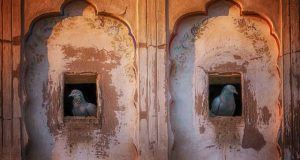Emily Conover in Science News:
 In keeping with a mathematical concept known as the pigeonhole principle, roosting pigeons have to cram together if there are more pigeons than spots available, with some birds sharing holes. But photons, or quantum particles of light, can violate that rule, according to an experiment reported in the Jan. 29 Proceedings of the National Academy of Sciences.
In keeping with a mathematical concept known as the pigeonhole principle, roosting pigeons have to cram together if there are more pigeons than spots available, with some birds sharing holes. But photons, or quantum particles of light, can violate that rule, according to an experiment reported in the Jan. 29 Proceedings of the National Academy of Sciences.
The pigeonhole principle states that, if three pigeons are roosting in two holes, one hole must contain at least two birds. Though seemingly obvious, the idea helps define the fundamentals of what numbers are and what it means to count things. But in the quantum realm, scientists had predicted that three “pigeons” — technically, quantum particles — could squeeze into two holes without any one particle sharing a hole with another, in what’s known as the quantum pigeonhole effect (SN Online: 7/18/14).
The “quantum pigeonhole effect challenges our basic understanding…. So a clear experimental verification is highly needed,” study coauthors Chao-Yang Lu and Jian-Wei Pan, physicists at the University of Science and Technology of China in Hefei, wrote in an e-mail. “The quantum pigeonhole may have potential applications to find more complex and fundamental quantum effects.”
In the study, three photons took the place of the pigeons.
More here.
